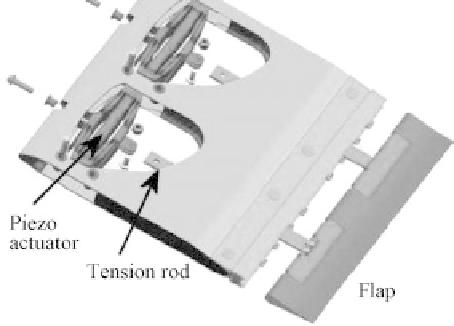Environmental Engineering Reference
In-Depth Information
Figure 6: The piezoelectric stack driven concept by Enenkl (fi gure adapted
from [ 54 ]).
There are several ways at which the fl ap can be controlled by adaptive materials.
The following are elaborated in literature. Lee and Chopra [53] proposes a so-called
piezo-based 'double L' amplifi er. This mechanism drives the fl ap. Enenkl [54] pro-
posed a similar system which consists of a piezo stack between two leaf springs. The
Enenkl concept (see Fig. 6) has been tested on a full-scale helicopter rotor.
Bothwell [52] elaborates on a magnetostrictive driven torsion tube but he also
mentions SMA wires for twisting the tube. Other torsion tube options [55] use
pure piezo tubes by evoking twist in the piezo ceramic elements. Another way to
drive the fl ap would be to employ the piezo ceramic in a bender and to use that
bender to actuate the fl ap close to its hinge, thus amplifying displacement induced
by the bender [56, 57]. A fi nal application is to use SMA wires to pull the fl ap in
either direction [58].
All these helicopter rotor trailing edge concepts are based on hinged fl aps. This
is not wanted in wind turbine rotor trailing edge fl aps because of maintainability
issues. Helicopters are already subjected to mandatory, regular inspections and
rotor blades are replaced regularly.
2.2.2 Active twist
With helicopter blades another option has been researched, although less thor-
oughly than trailing edge fl aps. This is to twist a section of the blade to infl uence
the aerodynamics. Such a system could theoretically replace the cyclic pitch sys-
tem, but the defl ections are not large enough, so the goal remains vibration control
[59]. With active twist a piece of the blade at the root can be twisted. Two technical
implications can be distinguished. One is to apply adaptive materials under an angle
to induce shear and thus torque. The second one is to apply an angled laminate with
longitudinal applied adaptive materials. This induces the same type of shear. Pos-
sibilities are mentioned by Chopra [56], Strehlow and Strehlow [60] and Barrett
et al
. [59]. Barrett makes a comparison for different twist inducing confi gurations

Search WWH ::

Custom Search